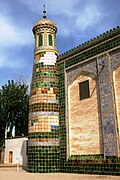Top Qs
Timeline
Chat
Perspective
Afaq Khoja Mausoleum
Religious mausoleum in Kashgar, Xinjiang, China From Wikipedia, the free encyclopedia
Remove ads
The Afaq Khoja Mausoleum is a mausoleum in Xinjiang, China; it is the holiest Muslim site in the region. It is located some 5 km northeast from the centre of Kashgar,[1] in Haohan Village (浩罕村; Ayziret in Uyghur),[2] which is also known as Yaghdu.[1] The shrine is visited by sightseers and has been designated as a tourist attraction by Chinese officials.[3][4][5]
Remove ads
History
The mazar (mausoleum) was initially built in ca. 1640 as the tomb of Muhammad Yūsuf, a Central Asian Naqshbandi Sufi master who had come to the Altishahr region (present-day Southern Xinjiang) in the early 17th century and possibly was also active in spreading Sufism in China proper.[6] Later, Muhammad Yūsuf's more famous son and successor, Afāq Khoja, was buried there as well in 1694. As believed, the tiled mausoleum contains the tombs of five generations of the Afāqi family, providing resting places for 72 of its members.
Remove ads
Description
The mausoleum is perhaps the finest example of Islamic architecture in Xinjiang. A large dome of 17 m is at the center surrounded by four corner minarets with stripes and arabesque floral patterns.[7] Each of the windows of the minarets are in a different geometric pattern while the tops have turrets with an inverted lotus dome and scalloped edges. The entrance to the mausoleum is a majestic facade and a tiled iwan-niche style typical of Central Asian mosques.[7]
The tombs are decorated with blue glazed tiles and draped in colorful silks. Inside the tomb hall is the Casket of Iparhan which supposedly carried her from Beijing.
There is a mausoleum, four prayer halls which are supported by wooden beams with muqarnas on the capitals, a lecture hall and a cemetery which is still in use by the Ugyhur population and has distinctive mud and brick tombs.[7] A gateway also has blue glazed tiles and there is a pond in the courtyard for people to cleanse before entering.[7]
Remove ads
Gallery
Chinese tourism
In 2015, officials opened a tourist park named Xiang Fei Garden near the mausoleum. The shrine is visited by pilgrims and sightseers especially China's ethnic-Han majority, and has been designated as a tourist attraction by Chinese officials.[3][4][5][8]
References
Wikiwand - on
Seamless Wikipedia browsing. On steroids.
Remove ads






